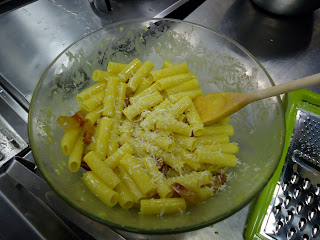The basis of origin of eggplant parmesan is mainly from the southern parts of Italy supposedly claimed by both Campania and Sicily even though when translated "parmigiana" traditionally means "from Parma," (this is unrelated to Parmesan cheese) but Parma is a Northern city in Italy, which does not relate to the beginning creations of the parmigiana di melanzane. The Italian versions of parmigiana are only vegetarian, which is why you won't find chicken or veal parmigiana in Italy however around the world you can find chicken and/or veal parmigiana in various restaurants.
The basic preparation for a "parmigiana" is basically having the eggplant sliced thin and fried (usually in olive oil) and then layered with tomato sauce and cheese, which is then baked in the oven. The main focus of the dish either eggplant, chicken, or veal must be thinly sliced and pan fried in oil to create the "filling" of the parmigiana. Then it is layered with tomato sauce and cheese, usually the tomato sauce is the first layer, then the eggplant or meat, and finally the cheese. This continues until you have used all of your ingredients based on your recipe. The various types of cheeses to use in parmigiana include hard cheese like Parmesan or Pecorino or soft cheeses like Mozzarella or Caciocavallo. Some even use a combination of hard cheese/soft cheese to create this wonderful dish for people to enjoy.
The eggplant parmigiana that I had at Hostaria del Moro aka "Tony's" in Trastevere.
Here is a recipe for one version of a traditional eggplant parmesan*
1 cup extra-virgin olive oil
2 cloves garlic, peeled and minced
1 28-oz. can crushed Italian tomatoes
Salt and freshly ground black pepper
Flour
3 eggs
1 1/2 cups dried plain bread crumbs, sifted
1 large eggplant
12 fresh basil leaves, torn into pieces
1/4 cup freshly grated parmigiano-reggiano
3/4 cup grated provolone
1. Preheat oven to 375°. Heat 1/4 cup olive oil and garlic in a medium saucepan over medium heat until garlic is fragrant, about 1 minute. Add tomatoes, season to taste with salt and pepper, and simmer, stirring, until sauce thickens, about 30 minutes.
2. Meanwhile, place flour in a shallow dish. Beat eggs together in another shallow dish. Mix bread crumbs with a generous pinch of salt and pepper in a third shallow dish. Set dishes aside.
3. Peel and trim eggplant and slice lengthwise into 1/2'' pieces. Dredge each slice first in the flour, then in the egg, then in the seasoned bread crumbs.
4. Heat remaining ⅛ cup oil in a large cast-iron skillet over medium-high heat until oil is hot but not smoking. Add breaded eggplant slices to the hot oil (working in batches, if needed) and cook until golden on both sides and dark brown on the edges, 2-3 minutes per side.
5. Spread a thin layer of tomato sauce in the bottom of a large shallow ovenproof dish. Arrange eggplant in a single layer on top of tomato sauce. Spoon remaining sauce over eggplant. Scatter basil on top of sauce and sprinkle with parmigiano-reggiano, then provolone. Bake until sauce is bubbling and cheese is melted, about 20 minutes.
*Note: there are many versions of eggplant parmesan that can be made along with different forms of parmigiana with chicken or veal. This is just a sample of what is typically done for a parmigiana recipe.


